Hyundai Santa Fe Review 2024
Written by Andrew Brady
Quick overview
Pros
- Impressive versatility
- User-friendly infotainment
- Even the cheapest model is well equipped
Cons
- Performance from the hybrid model is leisurely
- A Skoda Kodiaq is significantly cheaper
- Not everyone will like how it looks
Overall verdict on the Hyundai Santa Fe
"The Hyundai Santa Fe manages to combine rugged off-roader looks with impressive versatility and a tech-heavy cabin. Not everyone will like the cut-price Land Rover Discovery exterior, but the new Hyundai Santa Fe's designers can't be accused of dialling it in. It's an interesting take on the seven-seat family SUV... and we think that's a good thing."
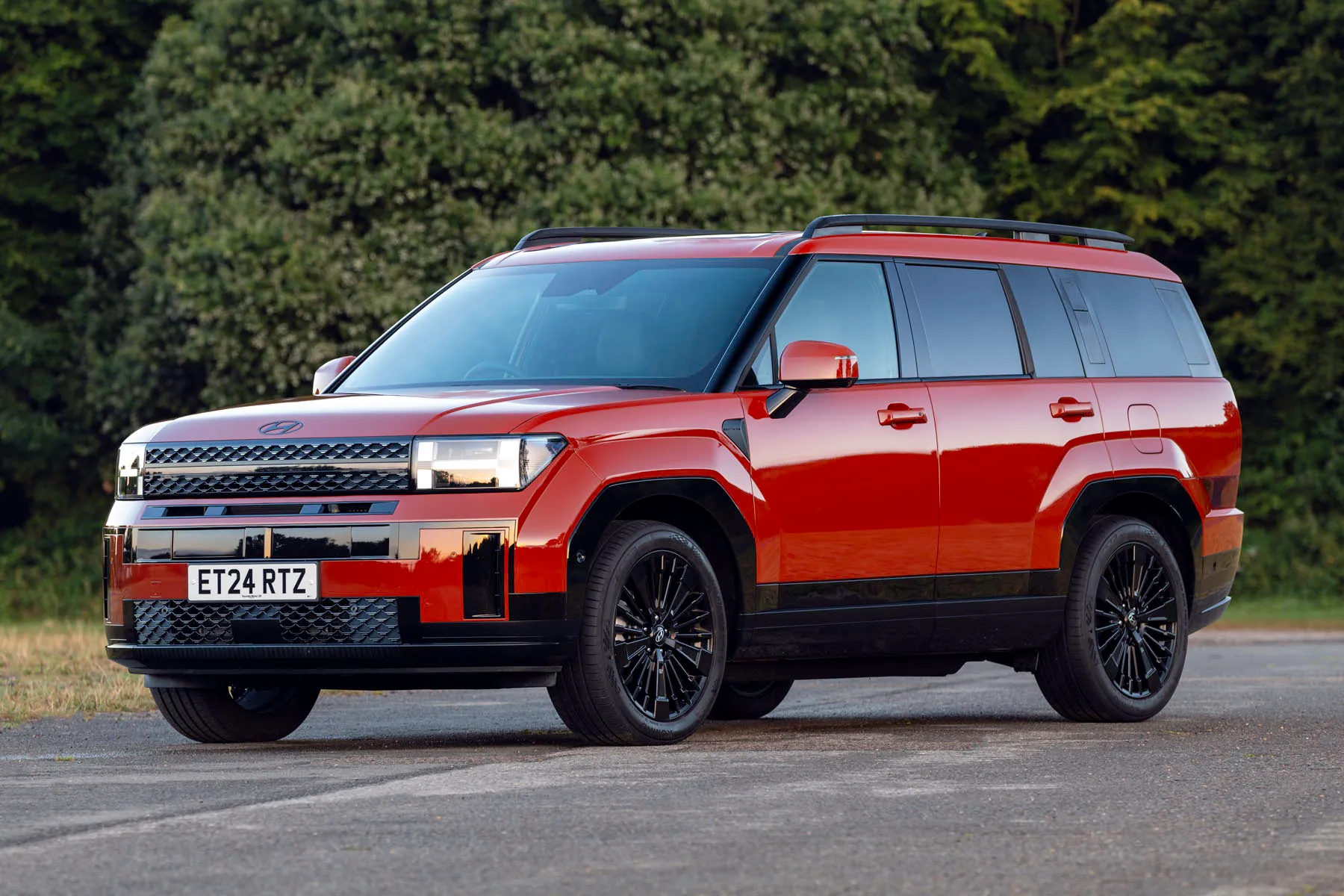
Designed and developed during the great Covid era, the new Hyundai Santa Fe is intended to be the ultimate car for self-sufficient weekend adventures. While most family SUVs are marketed around adventurous lifestyles, the 2024 Santa Fe takes things a step further. It intends to bridge the gap between work and play, providing a versatile interior space that can be used as an office during the week and a comfortable hideaway at weekends.
Its creators refer to the Hyundai Santa Fe's cabin as 'the box' - a spacious interior with up to seven seats and an optional inflatable mattress that can fit in the back of the car. Not ready to embrace car camping? Its wide-opening rear tailgate can accommodate golf clubs width ways, while there's even a hidden handle in the C-pillar, allowing you to stand on the rear wheel and attach extra luggage to the roof.
The Hyundai Santa Fe is initially being launched with three trim levels: Premium, Ultimate and Calligraphy. Even the most affordable Hyundai Santa Fe Premium isn't exactly a budget option, with prices starting from around £47,000 (around £10,000 more than the cheapest Skoda Kodiaq). It's very well equipped, though, so much so there's not necessarily much point in paying more for one of the pricier trim levels.
You can get it with hybrid power or plug-in hybrid power. Both combine a 1.6-litre petrol engine with an electric motor. We think the regular hybrid model feels pretty underwhelming, its modest power output struggling to deal with the Santa Fe's weight. The plug-in hybrid is better, but needs regular charging for maximum efficiency. There aren't any plans for a diesel Santa Fe - a shame, we reckon, although unsurprising in 2024.
Looking for a used car for sale? We've got 100s of Hyundai Approved Used Cars for Sale for you to choose from, including a wide range of Hyundai Santa Fe cars for sale.
Is the Hyundai Santa Fe right for you?
If you've got a big family and want a rugged, spacious SUV, the new Hyundai Santa Fe is a great choice. It's a bit expensive and not everyone will like how it looks, but it starts to look like reasonable value for money when you compare it like-for-like with premium competitors.
What’s the best Hyundai Santa Fe model/engine to choose?
Don't spend big bucks on one of the top-end models - the entry-level Hyundai Santa Fe Premium is very well kitted out, with spec highlights including a 12.3-inch navigation system, heated leather seats and navigation-based smart adaptive cruise control. We'd choose the plug-in hybrid over the hybrid, but only if you can charge a car at home - without regular charging, it won't be very efficient.
What other cars are similar to the Hyundai Santa Fe?
The Hyundai Santa Fe competes with a range of seven-seaters, including the Kia Sorento and all-electric Kia EV9, as well as the popular Skoda Kodiaq and Peugeot 5008. Its premium price tag also pitches it against the Land Rover Discovery Sport (you could even say it's an affordable alternative to a Discovery or a Defender), as well as the BMW X3 and Mercedes GLB.
Comfort and design: Hyundai Santa Fe interior
"While the previous Hyundai Santa Fe was a bit dull and drab inside, that's not an accusation that can be thrown at the new car. It looks (and feels) every bit the premium SUV, with soft-touch materials, impressive technology and even a range of interior colours to choose from."
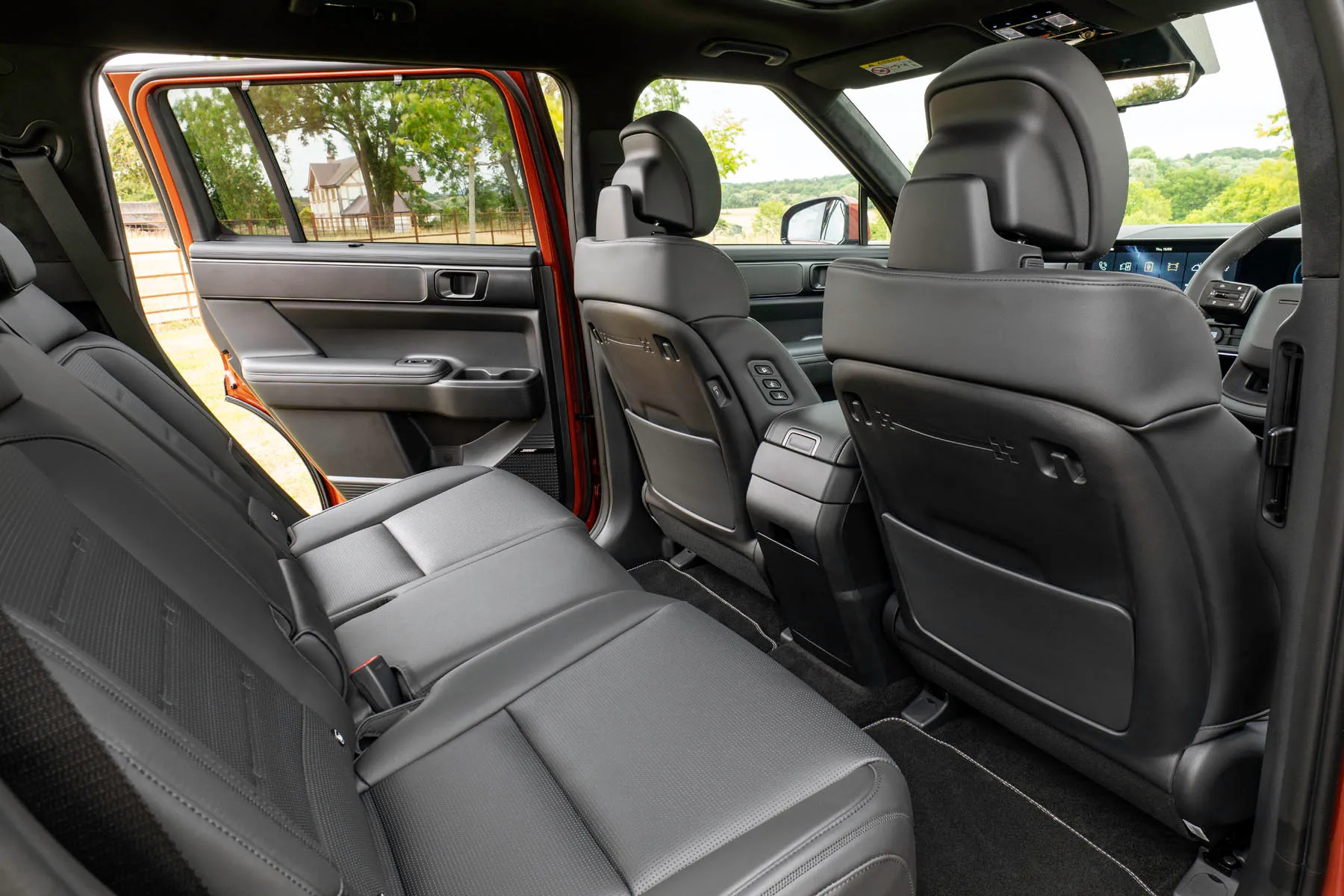
The new Hyundai Santa Fe has been designed with an emphasis on rear space. That means it's extraordinarily spacious back there, while buyers get the choice of six or seven seats. An abnormally large boot opening helps with loading whatever you wish to carry - and there's even enough space to drop the rear seats and use the Santa Fe as a hotel-on-wheels, if you wish.
The steering position is spot on, giving you a lofty view of the road ahead. Visibility in all directions is excellent, while there's an array of tech available to make your life easier - including, on top-spec Calligraphy models - a digital rear-view camera.
Infotainment comes in the form of two curved 12.3-inch displays that run across the dashboard and behind the steering wheel. These look modern and high-tech, but not at the expense of useability. We like that the Hyundai Santa Fe still comes with easy-to-reach knobs and buttons that act as shortcuts for the infotainment system or tweaking the temperature of the climate control.
Quality and finish
We wouldn't say the new Hyundai Santa Fe feels quite as posh as, say, a Land Rover Discovery or Volvo XC90 inside. It's cheaper than its upmarket rivals, though, and it certainly feels a cut above a Skoda Kodiaq or Peugeot 5008.
You don't need to splash out on one of the most expensive Hyundai Santa Fe models for a pleasant cabin, either. The entry-level Santa Fe Premium has soft-touch materials aplenty, while leather seats add to the high-end vibe. If you do buy a top-spec Hyundai Santa Fe Calligraphy, you'll get premium nappa leather seats as standard, which adds to the overall feeling of quality.
Infotainment: Touchscreen, USB, nav and stereo in the Hyundai Santa Fe
All Hyundai Santa Fe models come with a slick curved display featuring two 12.3-inch screens, acting as the central infotainment display as well as a digital instrument cluster. It's a superb system to use, with speedy responses and sharp graphics as well as intuitive menu layouts. Wireless Apple CarPlay and Android Auto are on hand to provide easy access to your favourite phone apps, while a wireless phone charger keeps your phone topped up.
Hyundai's thought of a few trick features to prevent arguments between passengers, too. Ultimate and Calligraphy models come with not one but two wireless chargers in the front - meaning both the driver and front-seat passenger can charge their phone at the same time. And all three rows of seats get USB-C chargers for faff-free phone charging.
From early 2025, Hyundai Santa Fe drivers will be able to choose from a variety of Hyundai's Bluelink connectivity subscription services. The most basic one - Bluelink LITE - will be free for 10 years and will let you use your phone as a digital key, check on your car remotely and download over-the-air updates.
Space and practicality: Hyundai Santa Fe boot space
The Hyundai Santa Fe's design centres around 'the box' - essentially a large, versatile area that can be used for carrying up to seven passengers and their luggage, but with the ability to drop the seats and use it as a terrace on wheels or even a comfortable camping pod for overnight adventures.
It's hugely practical, with a seat-up boot capacity of up to 628 litres in the hybrid or 621 litres in the PHEV. Drop the rear seats and the Santa Fe can carry nearly 1950 litres of luggage.
Passenger space is suitably vast as well, with more than a metre of headroom for those in the front and middle-row seats, and still-generous room in the third row of seats (which fold flat into the floor when not needed).
It's not all about outright space, either. There are various neat little touches intended to make life easier. The boot opening is unusually wide, for example, meaning you can easily squeeze in a set of golf clubs width-ways. Looking to carry luggage on the roof? The top-spec Calligraphy trim comes with a hidden handle in the C-pillar, providing a little extra support should you wish to stand on the rear wheel.
Looking to squeeze the Hyundai Santa Fe into your garage? That might be a struggle. It measures 4830mm in length, 1900mm in width and 2815mm in height.
Handling and ride quality: What is the Hyundai Santa Fe like to drive?
"While the Hyundai Santa Fe is quite a large SUV, it's actually very easy to drive. You're helped out by impressive visibility and lots of driver-assistance tech, but it's no more intimidating to drive than a Volkswagen Golf."
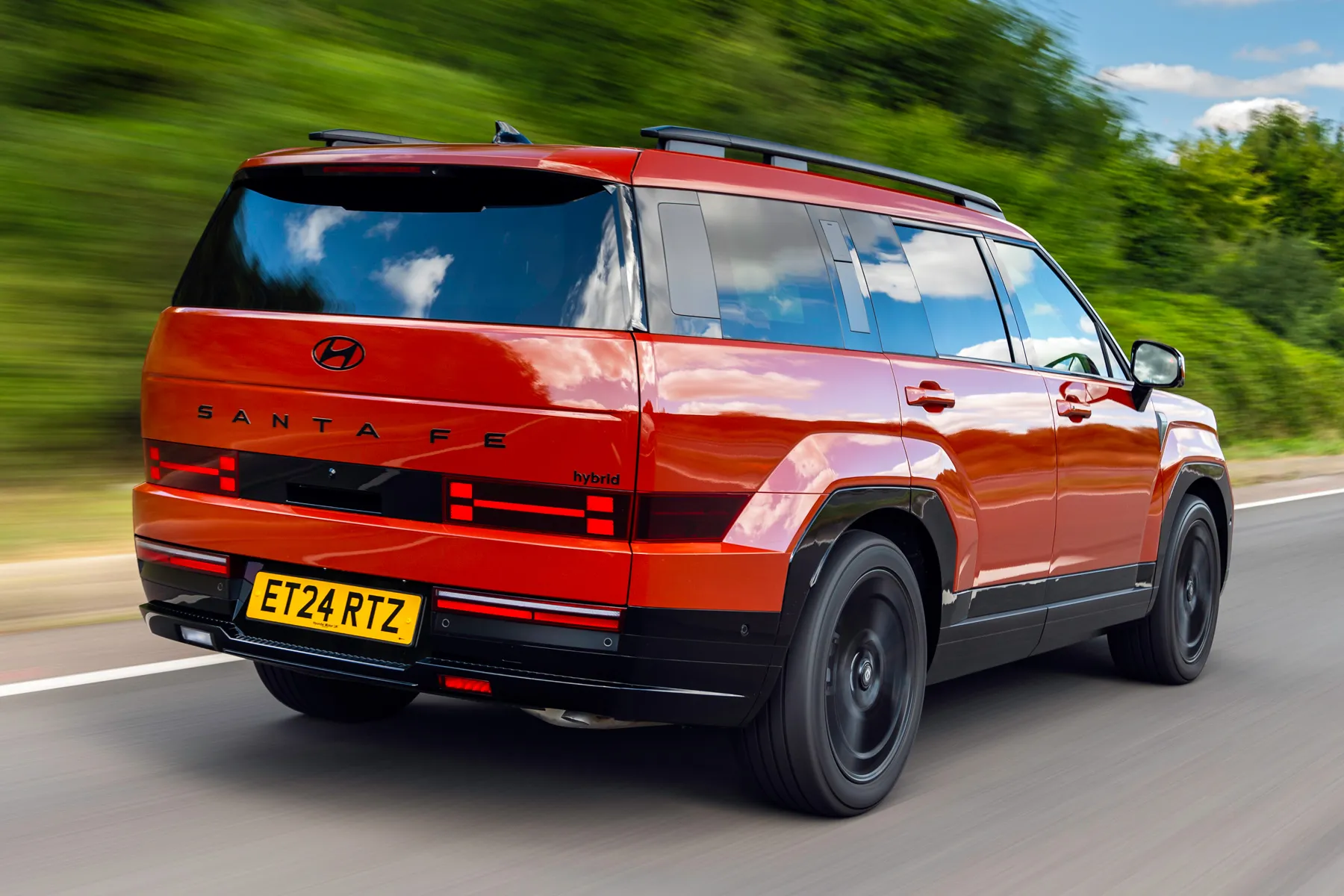
You'll notice the Hyundai Santa Fe's bulk if you throw it into a corner, but generally it rides and handles pretty neatly. The steering is reassuringly heavy (but not excessively so), while the suspension soaks up most lumps and bumps without too much discomfort. You'll notice a bit of road noise from the 20-inch alloy wheels at higher speeds, but it's nothing that can't be drowned out by turning up the radio.
With a choice of hybrid and plug-in hybrid powertrains, your decision on which Hyundai Santa Fe will fit into your life best will depend on the kind of driving you cover. If you have off-road parking and can plug your car in at home, the plug-in hybrid will make sense for a lot of buyers - especially as its 33-mile electric range ought to be enough for a short commute or running the kids to school.
Both hybrid and plug-in hybrid Santa Fes come with paddles behind the steering wheel that can be used to adjust the amount of regenerative braking - that's how much the car slows down when you lift off the accelerator. It won't quite come to a complete halt with it ramped up to the max, but it does slow down noticeably, pumping energy back into the battery and saving your brake pads in the process.
What engines and gearboxes are available in the Hyundai Santa Fe?
No diesel here: buyers get a choice of hybrid or plug-in hybrid power.
The most affordable Hyundai Santa Fe is the hybrid, which combines a 1.6-litre petrol engine with an electric motor and a choice of two- or four-wheel drive. Performance is adequate - it'll accelerate from a standstill to 62mph in a smidgen under 10 seconds (9.6 seconds, to be exact, or 9.8 seconds for the 4x4).
With a chunk of extra power (253PS compared to 215PS), the Hyundai Santa Fe PHEV feels a fair bit quicker than the hybrid. It'll accelerate to 62mph in 9.3 seconds - which is still fairly relaxed - but it feels punchier than that, especially for mid-range overtakes.
All Hyundai Santa Fe models come with an automatic gearbox, which is responsive enough. There's a slight hesitation when you plant the throttle pedal, but it'll drop down when necessary. You can always switch to sport mode for snappier responses but there's not a huge amount to be gained by doing so.
Refinement and noise levels
The Hyundai Santa Fe is a very relaxing car to travel in. On both hybrid and plug-in hybrid models, the engine and electric motors work well together, meaning you won't notice too much of a commotion as the petrol engine kicks in and out. For maximum refinement, go for the PHEV - it'll travel under electric power alone, meaning you get all the refinement of a pure-electric car (until it runs out of electricity, anyway).
Safety equipment: How safe is the Hyundai Santa Fe?
While the latest Hyundai Santa Fe is yet to be crash-tested by Euro NCAP, it's likely to be an exceptionally safe way of transporting your family.
For a start, it's fitted with no fewer than 10 airbags, not to mention an extensive list of driver-assistance technology. As an example, the Forward Collision Avoidance Assist can detect other cars, pedestrians and cyclists - applying the brakes if necessary to prevent a collision. The Highway Drive Assist, meanwhile, will keep the Santa Fe a set distance from the car in front, while also maintaining its position in the centre of its lane.
Most of the driver-assistance features are standard across the Santa Fe range, although the Ultimate and Calligraphy models come with a more advanced version of the Forward Collision Avoidance Assist, as well as a clever Surround View Monitor and Remote Smart Park Assist.
MPG and fuel costs: What does a Hyundai Santa Fe cost to run?
"Hybrid power means the Hyundai Santa Fe should be fairly cheap to run, while its five-year warranty will give you some reassurance on the reliability front, too."
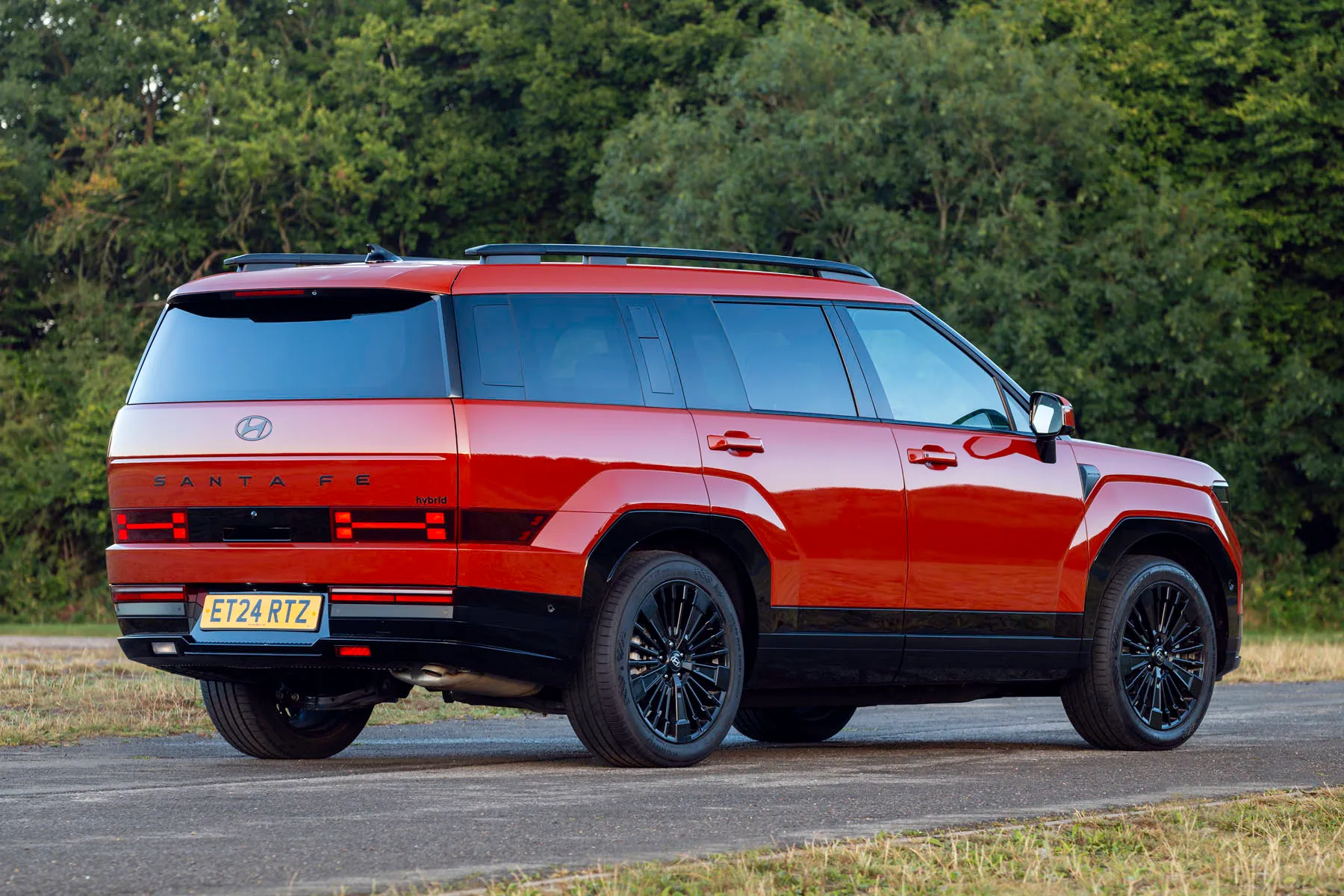
According to official tests, the hybrid Hyundai Santa Fe manages 40.4mpg (or 38.4mpg from the 4x4 model) - that's pretty reasonable for the size of the car, although diesel alternatives will be more efficient in the real world (especially during motorway driving).
The Hyundai Santa Fe PHEV will be more frugal if you keep it topped up with electricity. Officially, it can travel up to 33 miles under electric power alone - that's ideal if you have a short commute but want to travel further afield at the weekend. The 166.0mpg figure that Hyundai claims should be taken with a pinch of salt unless you rarely drive more than the 33-mile electric range.
How reliable is a Hyundai Santa Fe?
We'd expect the new Hyundai Santa Fe to be a very reliable SUV. Previous generation models have been very reliable, while Hyundai as a brand generally performs well in ownership surveys. Like all Hyundais, the Santa Fe comes with a five-year, unlimited-mileage warranty. That's pretty impressive and more than you'd get with, say, a Skoda Kodiaq. The Kia Sorento comes with a seven-year warranty, but it's limited to 100,000 miles.
Insurance groups and costs
Insurance groups for the new Hyundai Santa Fe are yet to be confirmed.
VED car tax: What is the annual road tax on a Hyundai Santa Fe?
With a price tag of more than £40,000, the Hyundai Santa Fe qualifies for so-called 'premium car tax'. That means you'll pay £600 a year in tax (for years two to six), minus a £10/year discount for being a hybrid. After the sixth year, this'll drop to the standard rate - currently £180/year for hybrids.
How much should you be paying for a used Hyundai Santa Fe?
"The cheapest Hyundai Santa Fe now starts from nearly £47,000, while the most desirable plug-in hybrid models are more than £57,000. That's a premium price tag - but it still undercuts the Land Rover Discovery and all-electric Kia EV9."
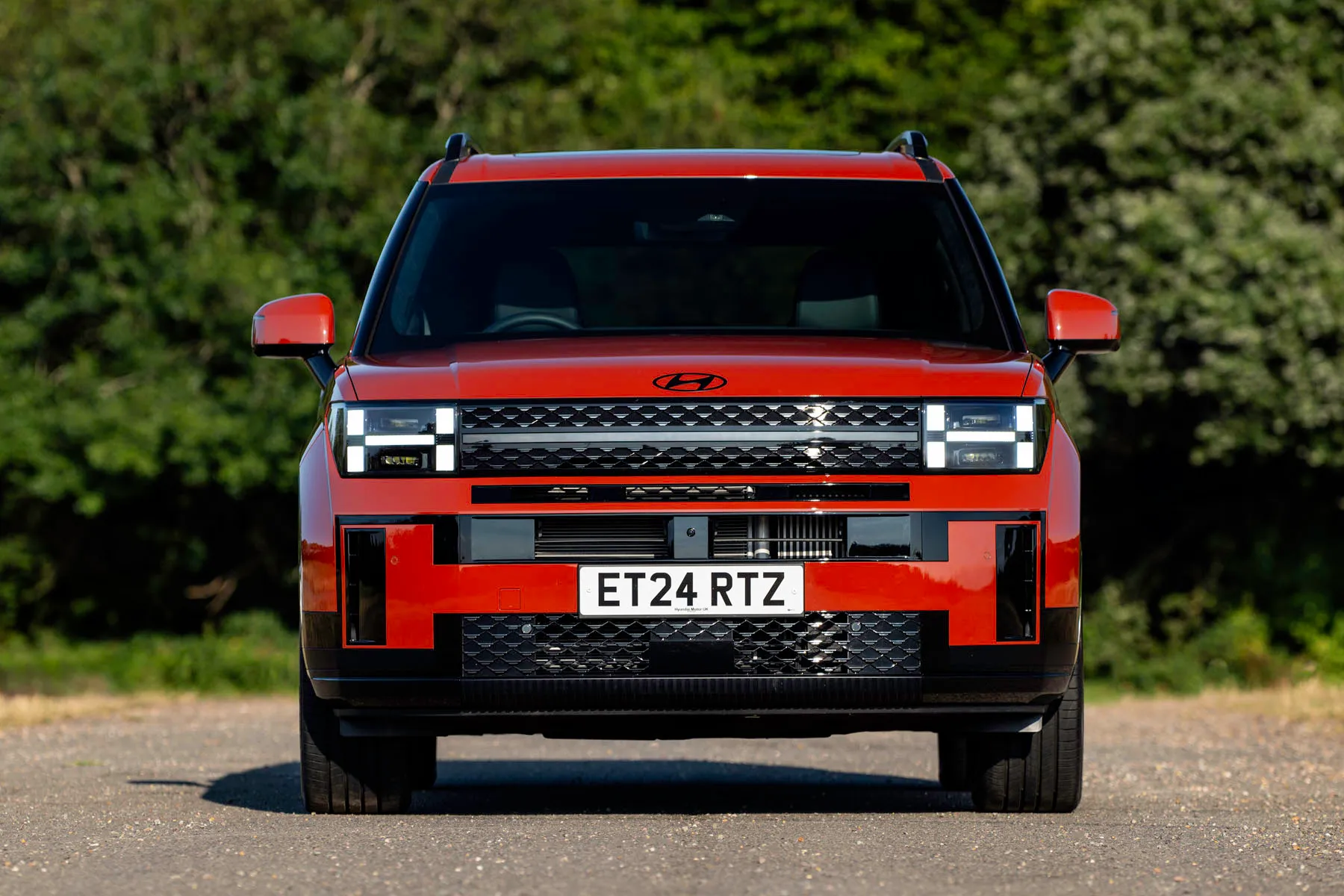
Even though it's a very new car, you can already buy a nearly-new Hyundai Santa Fe on heycar. We've seen one dealer advertising a pre-registered plug-in hybrid Santa Fe Calligraphy for £52,216 - a saving of nearly £5,500 off a brand new car.
Trim levels and standard equipment
The range starts with the Hyundai Santa Fe Premium. Standard equipment includes a 12.3-inch navigation system and a 12.3-inch digital instrument cluster. Parking sensors (front and rear) are also standard, as well as a heated steering wheel and navigation-based smart adaptive cruise control. The Premium model also comes with a smart electric tailgate as well as a single wireless phone charging pad, dual-zone climate control, leather seats (heated in the front), keyless entry/start and rear door blinds.
The Hyundai Santa Fe Ultimate adds a Bose premium sound system, head-up display, digital rear-view mirror and a dual wireless phone charging pad. The front seats are both heated and ventilated, while the rear seats are heated. A dual glass sunroof is standard, too, as well as a range of driver-assistance technology (including Highway Drive Assist 2, Forward Collision Avoidance Assist 2 and a Surround View Monitor - more about these in the 'safety equipment' section above).
The range-topping Hyundai Santa Fe Calligraphy comes with a UV-C tray, Nappa leather interior (black), front relaxation seats, 20-inch alloy wheels (black) a hidden handle in the C pillar and black exterior body styling.
Ask the heycar experts: common questions
How big is the new Hyundai Santa Fe?
Is there a new Hyundai Santa Fe diesel?
How popular is the new Hyundai Santa Fe?
Hyundai Santa Fe Alternatives
Get our latest advice, news and offers
Keep me updated by email with the latest advice, news and offers from heycar.
By submitting you agree to our privacy policy





